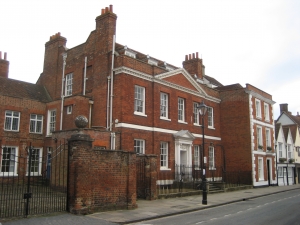 © Courtesy of Friends of Abingdon
© Courtesy of Friends of AbingdonAbbey Gateway, Abbey Close
The Gateway dates from the late fifteenth century and was the main entrance to Abingdon Abbey. A much-damaged statue of St.…

Abingdon Bridge, Bridge Street
Abingdon Bridge was built in 1416 by local town initiative, not by the Abbey. A guild named the Fraternity of the Holy Cross…

Baptist Church, 35 Ock Street
The Abingdon Baptist community dates from 1650, but it was not until 1700 that a dedicated chapel or meeting house could…

Barton Court (remains of) Sherwood Avenue
Hidden away in a modern housing estate just outside the town centre is the ruin of Barton (often referred to as Barton Court).
The…

50 Bath Street, Stratton House
Stratton House dominates the small square that closes Bath (formerly Boar) Street since it was divided by Stratton Way in…

Brick Alley Almshouses, St Helen’s Churchyard
Brick Alley is the name of the almshouses facing into St Helen’s churchyard along its south side. The rear is on St Helen’s…
 (© From AAAHS photographic collection. Copyright owner unidentified.}
(© From AAAHS photographic collection. Copyright owner unidentified.}Caldecott House (demolished 1972, was on Caldecott Road)
Caldecott House was on the north side of Caldecott Road and at the time of its demolition in 1972 was one of the largest…

Checker, Abingdon Abbey, Checker Walk
The Checker dates from the 1260s and is one of the oldest of the surviving buildings of the great medieval abbey of Abingdon.…
 © Spencer White
© Spencer WhiteChrist Church, Northcourt
Christ Church opened in 1961 in the large Grade II listed barn at Northcourt Farm, the most important building on the site.…

Conduit House, Park Crescent
At the south-east corner of Albert Park, where Park Road and Park Crescent meet, there stands a small, hexagonal stone building. …

Former Congregational Church, The Square
This self-confident, classical-fronted building on The Square is the former Congregational Church. It marked the prominence…

The Crown & Thistle, Bridge Street
The Crown & Thistle is a multi-period courtyard inn, probably taking its name from the union of the crowns of Scotland…

County Hall, Market Place
This “exceedingly handsome” building – as John Betjeman described it – was erected between 1678 and 1683, primarily…

Former County Police Station, Bridge Street
About to be remodelled at the time of writing as part of the Old Gaol development, the former County Police Station dominates…

20 East St Helen Street, Twickenham House
This early Georgian building was built in 1756-7 for Joseph Tomkins. The Tomkins were among the leading families of the…

26 and 26A East St Helen Street
No. 26 East St Helen Street is the most complete surviving medieval house in Abingdon. It was built in 1431 and had two jettied…

28 East St Helen Street, Unicorn House
No.28 is one of the largest and most impressive houses in East St Helen Street. A building on the plot was identified in…

30 East St Helen Street, St Ethelwold’s
Behind the elegant Georgian façade of No.30 there is a long sequence of building and adaptation to new requirements. Archaeologists…

55 East St Helen Street
No.55 with its neighbour No.51 are part of a timber framed row of rental properties built some time around 1500. They belonged…

60 East St Helen St, The Malthouse
The present building is largely a reconstruction of the early twentieth century by local architect Harry Redfern (1861-1950)…

Guildhall, Bridge Street and Abbey Close
The Guildhall is a complex set of buildings, now linked together. At its heart is the mediaeval L‑shaped Hospital of St…

King’s Head and Bell, 10 East St Helen Street
There was an inn on this site before 1554 when it was noted in a survey as The Bell. Its status as a major inn in the Bury…

Lacies Court, Abingdon School, Park Road
Lacies Court is the headmaster’s house at Abingdon School but it had a long and colourful earlier history. In the Middle…

The former Lion Hotel, High Street (largely demolished)
The former Lion Hotel, High Street (largely demolished)In its heyday this popular establishment in High Street was formed…

